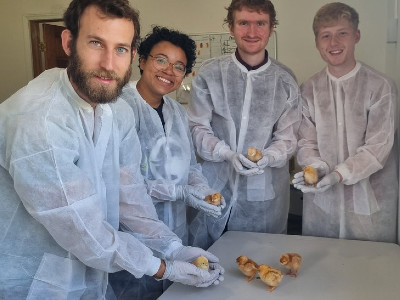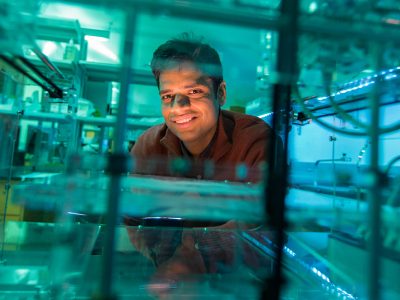When “egg-flation” hit in 2022, egg prices jumped nearly 50% as a result of bird flu killing off millions of egg-laying hens–the deadliest avian flu in U.S. history. The devastating outbreak was a wakeup call to the farming industry to improve the efficiency of the egg production process to avoid another poultry crisis. Today, egg prices may be receding, but two A&S researchers are helping a company test a new way that could increase the number of egg-laying hens.
There are currently a few known methods of stimulating egg production, with one example being to increase hens’ exposure to light. But what about sound? Could this be the “wave” of the future? The answer is yes, according to Israel-based startup company Soos Technology, who is using sound wave energy to boost the hen population and address age-old ethical and economical concerns within the egg industry.

Their proposed technology equips incubators with devices that introduce sound waves to fertilized eggs to alter gene expression. The result is genetically male chicks that express female physical traits, which means that these chicks will lay eggs. To help investigate this game-changing breakthrough from a genetic standpoint, Soos has teamed up with College of Arts and Sciences researchers at Syracuse University. James Crill, professor of practice in the Forensic Science Institute, and Steve Dorus, professor in the Department of Biology, are collaborating on the project along with a student research assistant funded by Soos for two years, and a former student hired to work on the project full time.
An Ethical Dilemma
At egg farms around the world, culling male chicks is a common practice because the males cannot lay eggs and aren’t used for meat. Out of around 15 billion chicks hatched each year worldwide, 7.5 billion chicks are euthanized after they hatch, costing farms billions in losses and raising questions about the ethical treatment of animals.
In Europe, some countries are already moving away from culling male chicks, as France, Germany, Italy, Austria and Luxembourg are in the process of banning this practice. To do this, they are requiring farms to implement technologies to detect the sex of the embryos before hatching, so they can be destroyed much earlier in the embryonic developmental process.
A Sound Treatment
Researchers at Soos Technology are perfecting a method that could further transform the egg industry. Sound waves, which have been used in the past to alter gene response in plants, can also alter gene expression in the fertilized chicken embryos, resulting in sex re-assigned chicks that are genetically males but express female physical traits. According to Soos Technology, the treatment is safe for the embryos, non-intrusive to the eggs, and does not involve any form of genetic modification or hormonal intervention.
The researchers control the environmental conditions in the incubator during embryonic development using sound energy produced by vibration. By altering the sound frequencies and volumes, and the humidity and temperatures within the incubator, Soos Technology claims they can increase the odds of hatching a female chick from 50% to near 80%.
A Central New York Collaboration
To scale up their groundbreaking technology and apply it to an agricultural setting, Soos Technology was awarded a $1 million grant through the Grow-New York competition. As part of the proposal, they were required to partner with a farm and university located in New York State. They formed a collaboration with a commercial farm located in Auburn, New York, around 30 minutes west of Syracuse, and Crill and Dorus.

The farm’s proximity to Syracuse University allows Crill, Dorus and A&S students to participate in hands-on research each step of the way. In addition to helping sort chicks on the farm, the faculty and student team is conducting microscopy and genetic analysis on embryos that have been shipped from the farm to campus labs.
“In our labs at Syracuse University we have a large experiment in place that is looking at genomic and RNA expression to find out what’s happening inside of the chicken during embryonic development that actually tells it to be a female but also have all the male genetics in place,” says Crill. “We are looking to determine how the sound waves are triggering certain female genes to be expressed over the male genes.”
Representatives from Soos Technology have been making periodic trips from Israel to Central New York throughout the implementation and hatching process. Their initial work involved installing and optimizing the incubators at the farm with the sound wave devices in early 2022. Since then, they have returned during hatching periods to document the success rate of their method by comparing the sex of chicks from a control group not exposed to the sound waves to a group that has received the treatment. Their early data shows promise, as around 61% of the hatched chicks who have undergone the Soos treatment have been female.
“The most significant discovery we found was that exposure to sound transmissions at certain frequencies and intensities in the hatchery significantly affects the sex change process, especially when it is performed from day 0 to day 16,” says Efrat Petel, general manager for Soos USA. “On Experiment 26, we found a 69% female ratio in one set and a 63% female ratio in another set. Our technology can influence the embryo to develop into a female, which is eventually able to lay eggs.”
In the coming months, Syracuse researchers will continue analyzing genetic data and performing statistical analysis to determine exactly how sound energy-based incubation is resulting in the production of functional female chickens from genetically male embryos. Their work could result in a new method of incubation that would revolutionize the poultry industry and save both billions of dollars and billions of chicks each year.


